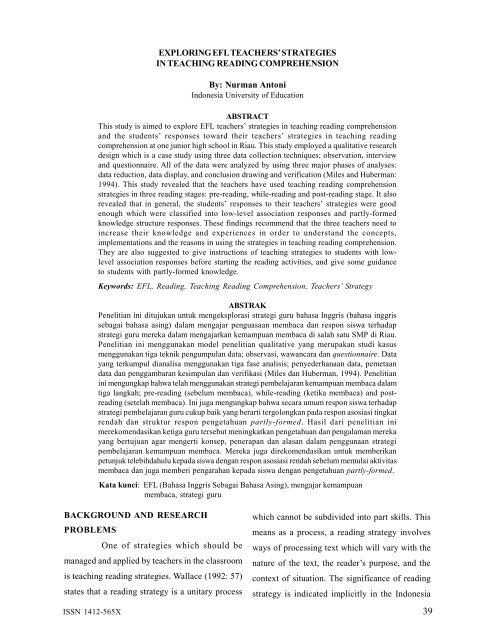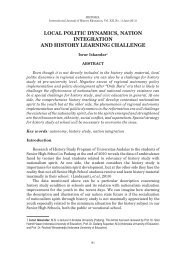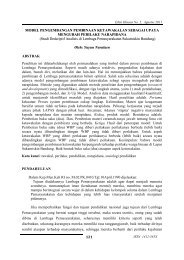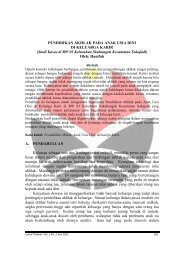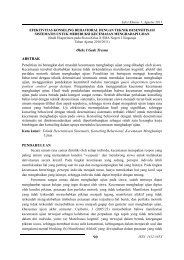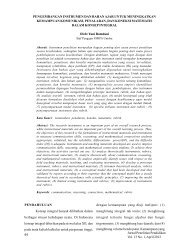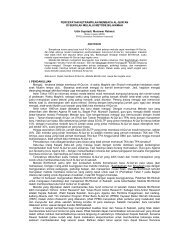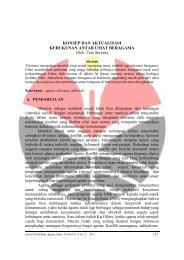STRATEGIES IN TEACHING READING ... - Jurnal UPI
STRATEGIES IN TEACHING READING ... - Jurnal UPI
STRATEGIES IN TEACHING READING ... - Jurnal UPI
You also want an ePaper? Increase the reach of your titles
YUMPU automatically turns print PDFs into web optimized ePapers that Google loves.
EXPLOR<strong>IN</strong>G EFL TEACHERS’ <strong>STRATEGIES</strong><strong>IN</strong> TEACH<strong>IN</strong>G READ<strong>IN</strong>G COMPREHENSIONBy: Nurman AntoniIndonesia University of EducationABSTRACTThis study is aimed to explore EFL teachers’ strategies in teaching reading comprehensionand the students’ responses toward their teachers’ strategies in teaching readingcomprehension at one junior high school in Riau. This study employed a qualitative researchdesign which is a case study using three data collection techniques; observation, interviewand questionnaire. All of the data were analyzed by using three major phases of analyses:data reduction, data display, and conclusion drawing and verification (Miles and Huberman:1994). This study revealed that the teachers have used teaching reading comprehensionstrategies in three reading stages: pre-reading, while-reading and post-reading stage. It alsorevealed that in general, the students’ responses to their teachers’ strategies were goodenough which were classified into low-level association responses and partly-formedknowledge structure responses. These findings recommend that the three teachers need toincrease their knowledge and experiences in order to understand the concepts,implementations and the reasons in using the strategies in teaching reading comprehension.They are also suggested to give instructions of teaching strategies to students with lowlevelassociation responses before starting the reading activities, and give some guidanceto students with partly-formed knowledge.Keywords: EFL, Reading, Teaching Reading Comprehension, Teachers’ StrategyABSTRAKPenelitian ini ditujukan untuk mengeksplorasi strategi guru bahasa Inggris (bahasa inggrissebagai bahasa asing) dalam mengajar penguasaan membaca dan respon siswa terhadapstrategi guru mereka dalam mengajarkan kemampuan membaca di salah satu SMP di Riau.Penelitian ini menggunakan model penelitian qualitative yang merupakan studi kasusmenggunakan tiga teknik pengumpulan data; observasi, wawancara dan questionnaire. Datayang terkumpul dianalisa menggunakan tiga fase analisis; penyederhanaan data, pemetaandata dan penggambaran kesimpulan dan verifikasi (Miles dan Huberman, 1994). Penelitianini mengungkap bahwa telah menggunakan strategi pembelajaran kemampuan membaca dalamtiga langkah; pre-reading (sebelum membaca), while-reading (ketika membaca) and postreading(setelah membaca). Ini juga mengungkap bahwa secara umum respon siswa terhadapstrategi pembelajaran guru cukup baik yang berarti tergolongkan pada respon asosiasi tingkatrendah dan struktur respon pengetahuan partly-formed. Hasil dari penelitian inimerekomendasikan ketiga guru tersebut meningkatkan pengetahuan dan pengalaman merekayang bertujuan agar mengerti konsep, penerapan dan alasan dalam penggunaan strategipembelajaran kemampuan membaca. Mereka juga direkomendasikan untuk memberikanpetunjuk telebihdahulu kepada siswa dengan respon asosiasi rendah sebelum memulai aktivitasmembaca dan juga memberi pengarahan kepada siswa dengan pengetahuan partly-formed.Kata kunci: EFL (Bahasa Inggris Sebagai Bahasa Asing), mengajar kemampuanmembaca, strategi guruBACKGROUND AND RESEARCHPROBLEMSOne of strategies which should bemanaged and applied by teachers in the classroomis teaching reading strategies. Wallace (1992: 57)states that a reading strategy is a unitary processISSN 1412-565Xwhich cannot be subdivided into part skills. Thismeans as a process, a reading strategy involvesways of processing text which will vary with thenature of the text, the reader’s purpose, and thecontext of situation. The significance of readingstrategy is indicated implicitly in the Indonesia39
National Curriculum of 2006. In this curriculum, itis stated that the objective of teaching reading, asone of the four major skills, in learning English asforeign language in junior high school is to developthe students’ ability to read and to get the messagecomprehensively from particular reading texts(BSNP, 2006). Relating to the essence of thiscurriculum, Nuttal (1996: 4) states that one of veryimportant reading purposes is to get meaning froma text. This means about the process how the readerdecodes the message from the text. In a similarvein, Nunan (1999: 249) exposed that an enormousamount of time, money and effort is spent forteaching reading in elementary and secondary schoolaround the world.In getting the meaning from the text, thereader needs a comprehension strategy. It issupported by (Hillerich, 1983: 125) that states themajor goal for any reading activities iscomprehension. It means that it has to do withstrategy to understand a written text. Manystrategies for teaching reading comprehension havedeveloped by experts such as Hillerich (1983),Tierney (1990), and Anderson (1999). More theoriesabout reading comprehension strategies are alsoproposed by Brown (2001) who delivers tenstrategies of teaching reading comprehension whichare related to bottom-up procedures and top-downprocesses. Whereas, Logsdon (2007) puts togetherPQ4R Strategies which stands for Preview,Question, Read, Reflect, Recite, and Review tohelp students improve reading comprehension.Furthermore, Barnet (1988), Wallace (1992) andNCLRC (2007) consider that teaching strategies inreading comprehension can be done by using threetechniques; pre-reading, while-reading and postreadingactivities.These strategies indicate an important roleof a teacher to reach the objectives of teachingreading comprehension. Generally, there are twofundamental responsibilities of a teacher in teachinga language in the classroom; to provide a languagerichlearning environment and to support studentsin their use of language (Lindfors, 1989). It meansthat an English teacher should create these twocomponents in teaching reading especially teachingreading comprehension. Regarding the teacher’srole in reading comprehension, Wallace (1992: 58)argues that the teachers with good strategy willobserve readers in the course of reading as to assessoutcomes in the form of answers to thecomprehension questions which generally follow areading task.Although many previous research reportshave given a comprehensive portrait on teachingstrategies of reading comprehension, the researcherthink that it is important to explore more about theteachers’ strategies used and the students’ responsestoward their teachers’ strategy on teaching readingcomprehension. In this case, this study focused toexamine the three English teachers and theirstudents who were learning reading comprehensionin appropriate texts at one junior high school.In line with the background of the study,the problem of this study is formulated as follows;(1) What strategies do the teachers use in teachingreading comprehension?; and (2) What are thestudents’ responses toward their teachers’strategies in teaching reading comprehension?LITERATURE REVIEW1. Reading ComprehensionReading comprehension skills areimportant for English language learners, especially40 <strong>Jurnal</strong> Penelitian PendidikanVol. 11, No. 2, Oktober 2010
for students who learn English as a foreign language.Reading comprehension is a process that involvesthe orchestration of the readers’ prior knowledgeabout the world and about language. It involves suchas predicting, questioning, summarizing, determiningmeaning of vocabulary in context, monitoring one’sown comprehension, and reflecting (Weaver, 1994:44). The most detailed one, Snow et al (2002, 11)defines reading comprehension as the process ofsimultaneously extracting and constructing meaningthrough interaction and involvement with writtenlanguage. They classify that comprehension entailsthree elements: They are the reader (consideringwith capacities, abilities, knowledge and experiencesthat a person brings to the act of reading), the text(including printer text or electronic text) and Theactivity (considering the purposes, process, andconsequences associated with the act of reading).Then, Grabe and Staller (2002) also deliverthat reading for general comprehension refers tothe ability to understand information in a text andinterpret it appropriately and correctly. However,reading comprehension abilities are quite complexand difference in numerous ways depending ontasks, motivations, goals and language ability. In this,the level of reader comprehension of the text isdetermined well from the interactions between thereader variables and the text variables (Barnet,1988).Moreover, Hillerich (1983: 126) classifiesreading comprehension into three levels: (1) literalcomprehension, (2) inferential comprehension, and(3) critical comprehension. Literal comprehensionlevel requires the reader to recall facts that areovertly stated in the text. For examples, it is to recallISSN 1412-565Xnames, things, and areas. Then, the inferentialcomprehension level allows the reader to suggestrelevant additional information based on the textconfronted and personal experience. It refers tounderstanding what an author meant and what wassaid, developing general conclusions, inferring mainidea, sequencing, making judgment, predictingoutcomes, etc. At last, the critical comprehensionlevel leads to the making of balanced judgmentsabout the author’s style and some other aspects ofthe text. It has to do with evaluating or makingjudgments in four major areas: central issues, supportfor those issue, language style, and logic used toarrive at conclusions.Given the above discussion, it can beconcluded that reading comprehension is the readeractivity to understand and to get information from atext with the simultaneous process. There are threecomponents that involve in this process. They are:the reader, text and activity. These three componentsrelate each others in various stages of readingcomprehension. They are: pre, while, and postreading activities. Thus, the levels of reader’scomprehension (literal, inferential, and critical) aredetermined well from the interaction among thosecomponents.2. The Strategies of Teaching ReadingComprehensionThis study focuses on teaching readingcomprehension strategies which are divided intothree reading stages proposed by some scholars,this includes: pre-reading stage, while reading stageand post reading stage (Hood et al, 2005; Gibbon,2002; Brown, 2001; Wallace, 1992; and Barnet1988).41
Pre-Reading StageIn this stage, one very popular kind ofactivities is brainstorming (Wallace, 1992: 91). Inline with this, Crawford et al (2005: 29) definebrainstorming as a method for creating many ideasabout a topic. In this activity, students are invited tocall out words, knowledge and experience thatrelevant to the text, relevant language and anexpectation meaning (Hood et al, 2005: 73 andWallace, 1992: 91, see also by Barnet: 1988).Generating text type or text structure isalso the activities that can be created in this stage(Barnet, 1988; Wallace 1992). Discussing the texttype in teaching reading comprehension is aimed tofamiliarize students with the major contextualfeatures of a text or text structure and to show howthese features can help them to work out the mainfunction of the text and the possible content (Hoodet al, 2005: 76; Tierney et al, 1999: 255).The next activity which can be applied issequencing picture (Hood et al, 2005; Gibbon, 2002;Barnet, 1988; Wallace, 1992). It is an activity togive a picture that related to the text and providerelevant background knowledge which set upexpectation meaning (Hood et al, 2005: 75; Gibbon,2002). It is also important for teachers to discussnew vocabulary with students in this stage becausediscussing new vocabulary can help them tocomprehend the text. When students have problemsof unknown words, teacher can encourage them touse dictionary. It is in line with Wallace’s (1992: 86)idea stated that teacher can encouraging studentsto use dictionary in pre-while stage. Another activityis predicting. This strategy is suggested to use by(Anderson, 1999; Pelinscar and Brown (1984) ascited in Doolitle, 2006).While-Reading StageIn this reading stage, a teacher cangenerate appropriate strategies to help students incomprehending the text. The common one is readingaloud activity which is recommended to use byGibbons, (2002); Hancock and Leaver (2006);Nuttal, (1996: 2). There are two kinds of readingaloud; reading aloud to students is can used as anopportunity to bring students into a popular cultureand an opportunity to challenging text and readingaloud by students is individual students to each othercan develop class cohesion and encourage studentsabout the text Handcock and Leaver (2006; 40).The next activity that teacher can generate in thisstage is silent reading. Anderson (2003) in Nunan(2003: 69) said that the majority of reading that wedo will be done silently. Anderson explained thatsilent reading is primarily in reading comprehensionbecause it focuses on getting meaning from print.Then, NCLRC (2007) also propose reread to checkcomprehension as one of while-activities in readingcomprehension.Post-Reading StageFor this stage, a teacher’s activity isprimarily to evaluate the students’ comprehensionin particular tasks as suggested by an onlinepublication; the National Capital LanguageResource Center (2007); Gibbons (2002: 91). In thiscase, Teachers can conduct such activities; scanningquestions, summarizing, learner’s purpose, andfollowing-up (Wallace, 1992; Barnet; 1988).Furthermore, Tierney et al (1990) also42 <strong>Jurnal</strong> Penelitian PendidikanVol. 11, No. 2, Oktober 2010
ecommend eight practical strategies forimprovement of teaching reading comprehension inthe classroom for appropriate levels. They are preptechnique, GIST, question-answer relationship,direct reading activity, vocabulary self-collectionstrategy, contextual redefinition, and text structurestrategy.Additionally, Brown and Palinscar (1984)in Doolittle (2006), Anderson (1999) and USANational Reading Panel (2000), propose predicting,questioning, clarifying, summarizing, monitorcomprehension, and justify comprehension as thestrategies that can be implemented in classroomactivities in teaching reading comprehension.3. The Role of Student’s Responses inLearningIn this study, as one of the aspects that tobe explored is the students’ response toward theirteachers’ strategies in teaching readingcomprehension. This study concerned with overtresponses (see May, 1966); they are the students’response of adjusting eyes and ears to their teachers’teaching strategies (sensory orientation response),response of putting the students’ mind to the teachingand learning process (paying attention response) andconcentrating attention on the relevant or importantsignals, and teaching aids or instructions in teachingreading comprehension (Targeting response). In asimilar vein, Langer (1982) in Tierney (1990) offersthe guidelines of analyzing to determine if studentshave well-performed, partly-performed, or illperformedknowledge structures in responding theirteachers’ strategies or instructions. Furthermore,Brown (2001) also delivers another way to analyzethe students’ response. According to him, becauseof reading is totally unobservable, it is important inISSN 1412-565Xreading to be able to accurately assess students’comprehension and development skill. So, we haveto infer comprehension from other behavior. Someof the following overt responses that indicatecomprehension: doing, choosing, transferring,answering, considering, extending, duplicating,modeling, and conversing.METHODOLOGY1. Research DesignThis present study employed a qualitativecase study design. A case study was chosenbecause this study was to observe and to explorethe teachers’ strategies on teaching readingcomprehension and the student’s responses towardtheir strategy used. In line with this, Cohen andManion (1994) and Gay (1992) state that a casestudy observes the characteristics of an individualunit-a child, a clique, a class, a school, or acommunity and attempts to shed light on aphenomenon by studying in depth a single caseexample of the phenomenon. It is an ideal design tounderstand and interpret observations of educationalphenomena (Merriam, 1988: 2). Then, the wholedesign of this qualitative case study was conductedsince the research designed which consist of theclear background of the study, the relevantsupporting theories, data collections, data analysis,and the conclusions.2. Research ParticipantsThe participants of this study were takenfrom all of EFL teachers who teach in SMPN 1Gunung Toar in Riau. There are three Englishteachers in this school with different experiencesand the degree of background knowledge. Becauseof that, the researcher considered all of them as43
the participants of this study. It is not to comparethese three teachers but to get concrete informationas much as possible about strategies in teachingreading comprehension. Besides, some studentswere chosen randomly for each class to get theinformation about their responses toward theirteachers’ strategies in teaching readingcomprehension.toward their teachers’ strategy. In expecting to getthe valid data as a whole, besides writing the fieldnotes, the researcher also had recorded by usingaudio-visual recorder all the events of teachingreading practice in the classrooms. In doing thisactivity, the researcher was helped by a volunteerassistance to record all the interactions by using asonny handy cam or an audio-visual recorder.3. Data Collection TechniquesAs it is mentioned earlier, this studyemployed qualitative research, precisely a qualitativecase study. So that, to explore the characteristicsand phenomenon of the single case, multiple datacollection techniques was intended to use. Theywere classroom observation, interviews andquestionnaire.Classroom ObservationThe classroom observation was conductedin order to identify the strategies used by EFLteachers and also to identify the students’ responsestoward their teachers’ strategies in teaching readingcomprehension. The idea of using an observationas the main data collection is related to the Flander(1960) as cited in Allwright (1988) who proposedobservation as the key procedure for a number ofresearchers who were interested not so much incomparing ‘methods’ as in investigating ‘teachingstyle’ in the hope of being able to find which onewas the most effective. In this study, the researcheras non-participant observer (Fraenkel and Wallen,2007: 450) conducted the classroom observation fora month period or four cycles for each participant.The first step, the researcher as a human instrumentdirectly observed the teachers’ strategies in teachingreading comprehension and the students’ responsesQuestionnaireIn the present study, the researcher hadused Likert Scale Questionnaire since this methodis simple, flexible and reliable (Dornyei, 2003: 36).Then, Dornyei (2003) also explained that LikertScale consists of a series of statements all of whichare related to a particular target with the respondentsare asked to indicate the extent to which they agreeor disagree with this items by marking one of theresponses ranging from ‘strongly agree’ to ‘stronglydisagree’. Then after the scale has beenadministered, each response option is assigned witha number for scoring purposes; it is usually 1 until 5for strongly agree and strongly disagree. Thequestionnaire was developed based on researchquestions. The data gather from questionnaire wereused to support the main data that get fromobservation. The data taking from the student’sanswers were considered to confirm and to findout the students’ responses toward their teachers’strategy used in teaching reading comprehension.InterviewThe interview was carried out before andafter the classroom observation. Kvale (1996: 35),and Cohen and Manion (1994) define interview asan interaction between two-person with theinterviewer for the specific purpose of obtaining44 <strong>Jurnal</strong> Penelitian PendidikanVol. 11, No. 2, Oktober 2010
esearch and with equally influencing each other.The interview was used merely to support the datafrom observation, because of that; the interview’squestions should be related to the points thatobserved in the classroom observation. The semistructured interview was used for this stage. It wasused because the researcher has general ideawhere the interview should go and what should comeout of it (Nunan, 1992). In the similar vein, Gay(1992: 232) explains that most interviews use semistructured approach involving the asking ofstructured questions followed by clarifyingunstructured or open-ended questions. He continuesthat the unstructured questions facilitate explanationand understanding of the responses to the structuredquestions. Thus, a combination of objectivity anddepth can be obtained, and results can tabulated aswell as explained.In the present study, there were twointerviews which named as interview beforeclassroom observation and the interview afterclassroom observation. Sometime, researcher callswith the first and the second interview. The firstinterview was conducted before taking theclassroom observation which applied to find out theteachers’ concept on the strategies in teachingreading comprehension. Then, the second interviewoccurred two months after the classroomobservation. In this study, the researcher had madeindividual interview with all the respondents in thetwo interviews because the researcher believed thatthere was enough time to make individualconversation or interview.RESEARCH F<strong>IN</strong>D<strong>IN</strong>GS ANDDISCUSSIONS1. The Teachers’ Strategies in TeachingReading Comprehension.As shown in data below, teachers’strategies in teaching reading comprehension waspresented into three teaching stages; pre-reading,while-reading and post-reading. It can be seen inthe following framework:A General Framework of Teachers’ Strategy in Teaching Reading ComprehensionTThe Strategies Used in Teaching Reading ComprehensionPre-Reading Stage While-Reading Stage Post-Reading Stage1. Generated reading aloud to and bystudents, and checked students’understanding about text by askingquestions while reading it.2. Asked students to identify new wordsand write the words on the board andallowed them to use dictionary to findmeaning.3. Asked students to find the genericstructure of the text.4. Asked them to retell the text by usingtheir own words.T1 1. Creating brainstorming to activate thestudent’s background knowledge.2. Mentioned title of the text and remindedtheir retelling homework3. Discuss the text type.4. Show a picture which related to the text.5. Discussing the new words related to thetopic.T2 1. Mentioned the topic, and wrote it on thewhite board and stated the title of the text.2. Discussed and explained ‘recount text’ asthe type of the text.3. Asked the meaning and the kind of theexpression.4. Translated his questions to Indonesian.T3 1. Asked their readiness to study.2. Asked students’ background knowledgeabout the ‘pet’.3. Students were suggested to confirm theirdictionary.4. Discussed and explained the text types andthe features.5. Used L1 to lead them understand herquestions1. Asked them to read quietly and askedthe main point of the text by askingquestions.2. Asked students to read aloud whilecheck their skill in reading3. Tried to lead students to makeconclusion about the text.4. Asked them to find the new words,wrote on the board, asked the meaningand suggest to use their dictionary5. Discuss the text type.1. Read aloud to and by students2. Asked them to find the new words3. Suggested to use dictionary to find themeaning of the words.4. Asked them to translate the text in frontof the class in fairs.5. Asked to read silently, and to find thenew words in two minutes.6. Asked to write the new words whichfound in the text on board.1. Asked students to do someappropriate tasks by reading thetext to find the information.2. Discussed students’ answersand clarified students’ answerto others.3. Asked them to know themeaning of the questions byusing dictionary4. She reviewed the lesson bygiving conclusion.1. Asked them to do individualtask2. Discussed the students’answer.3. Translated the questions whenthere wasn’t response4. Confirmed a student’s answerto others.5. Reviewed the lesson andexplained to them shortly.6. Asked to retell the passage byusing L1 for their homework1. Ask students to do appropriatetasks2. Discussed the answer andclarify the answer to the class.3. Translated the questions to getmore understanding.4. Asked questions for reviewingand explained for conclusion.5. Asked students to finddescriptive text from othersources for their homework.ISSN 1412-565X45
1.1. Pre-Reading StageDuring this stage, there were sometechniques and instructions done by the threeteachers as their strategies in teaching readingcomprehension. In general, the three teachers haveused brainstorming, encouraging the use ofdictionaries, discussing text types, and predicting.BrainstormingBrainstorming is one of the activitieswhich can be done in the pre-reading stage. ingeneral, the teachers activated their students’knowledge by asking questions of related wordswithin text or to the title given which were calledbrainstorming activities. It is in line with Hood’s(2005:73) argumentation that brainstorming, whichassociates as a PreP strategy (Mikulecky, 1990: 41),might occur around the topic title or picture.Furthermore, Crawford et al (2005: 29), Wallace(1992) and Barnet (1988) declared thatbrainstorming, as one of very popular tasks in prereadingactivities, can help to elicit backgroundknowledge and to activate necessary schemata.Encouraging the Use of DictionariesThe use of dictionaries in teaching readingcomprehension as a foreign language is verydominant. In this case, the three teachers of thisstudy seem to ask their students to consult dictionaryin teaching reading comprehension. This strategyis used when their students have problems in findingthe meaning of the new or difficult words in thepre-reading stage. It is in line with Cunningham’s(1989) suggestion to use a dictionary for verificationand Wallace (1992: 90) who proposes to usedictionary as a pre-reading support.Discussing Text TypesBased on the data gathered, one of themost frequent strategies which chosen by the threeteachers in the pre-reading stage is the discussionon text types. Based on the data, it seems that theteachers had done a strategy of discussing text typeor text structure strategy. In line with this, Barnet(1988) explains that one of the activities in prereadingstage is text type discussions. Then, McGee(1982) found that readers who are knowledgeableabout text structures have an advantage incomprehension and recall over readers who are notaware of the organization of texts. Furthermore,Anderson (1990) reported from his research onknowledge of text structure indicates that thereader’s understanding of how the text are organizedinfluences reading comprehension.PredictingTo involve the students’ prior knowledgewith the text, the teachers used predicting strategy.This fact is supported by Gibbons (2002: 84) sayingthat writing the title is one way of to ask students topredict the kind of text and what the text is about.From the discussion above, it can be assumed thatthe teachers had done predicting from titles as oneof the strategies to predict the content of the textthat they would learn. This in line with the strategyput forward by USA National Reading Panel (2000).This Panel’s report confirmed that prediction is oneof the strategies to ensure the students’comprehension.1.2. While-Reading StageBased on data gathered, there were somestrategies used by the three EFL teachers in teachingreading comprehension in the while-reading stage.In general the three teachers have used read aloud,reread strategy, directed reading strategy, vocabularycollection and redefinition strategy, and Giststrategy.46 <strong>Jurnal</strong> Penelitian PendidikanVol. 11, No. 2, Oktober 2010
Reading AloudAlthough term of read aloud is the classicstrategy in teaching reading, many teachers tend touse this strategy in various levels of students. Thisstrategy was also noted from the observations inthis present study. All teachers had used thisstrategy, whether reading aloud to students orreading aloud by students in teaching readingcomprehension. It is in line with Gibbon’s (2002)ideas that reading aloud plays an important role inthe development of reading competence and helpsstudents in making meaning. Furthermore, an onlinepublication, the National Capital LanguageResource Center (2007) stated that a person whoreads aloud and comprehends the meaning of thetext is coordinating word recognition withcomprehension in highly complex ways.Reread for Checking ComprehensionFocus on the students’ ability andimproving their control of language while readingthe text are other competences of a teacher inteaching reading comprehension. In the presentstudy, the teachers asked students to check ormonitor their comprehension while rereading the textin teaching reading comprehension as suggested byAnderson (1999: 47) and The National CapitalLanguage Resource Center (2007).Direct Reading ActivityIn this strategy, the students are asked toread the text silently and the teacher should prepareone or two comprehension-level questions for theirreading. In this case, the teachers used silent readingas a procedure of Direct Reading Activity (DRA).Related to this case, Crawford (2005: 42) statedthat DRA is a strategy for directing the students’ISSN 1412-565Xsilent reading with comprehension-level questionsby guiding them to key points in the text andproviding opportunities to discuss its meaning withtheir classmates. In addition, Tierney (1990)recommended the purpose of DRA is to giveteachers a basic format to improve students’ wordrecognition and comprehension skills.Discussing of Unknown wordsBased on the observation data, the threeteachers generated vocabulary activities in this stageby identifying unknown words from the text. In doingthis strategy, the teachers tried to lead the studentsto identify the difficult words to understand the text.In relation to this activity, Nation (1990) in Anderson(1990) stated that the most common method ofvocabulary instruction is to discuss the unfamiliarvocabulary as it naturally comes up and as part ofanother language activity. This method is used bystudents to memorize words paired with a shortdefinition or a synonym (Gipe, 1979 as cited inMikulecky, 1990).Retelling the Text.Based on data, a teacher tried to createthe interactions between students’ backgroundknowledge and the text by retelling the text. Sheasked students to write and read their retell. Sheasked them to retell the text by using their own wordsin their first language (L1). After students write theretelling, she asked some students to read anddiscuss it. It is in line with Hood’s (2005: 89) ideasthat in doing retelling, each student listens to othersretelling, and then the class discussed the similaritiesand differences with the different versions.1.3. Post-Reading StageIn this stage, the teachers had done theactivities which include: questioning, clarifying andjustifying comprehension, asking for specific47
questions, reviewing and follow-up strategy.Evaluating Comprehension in Particular TasksIn the present study, the three teachershad used questioning which is given under thereading text in various tasks. It is in line with TheNational Capital Language Resource Center’s(2007) report that suggested three kinds of activitiesto evaluate comprehension in the post-reading stage;evaluation of comprehension in a particular task,evaluation of overall progress in reading and inparticular types of reading tasks and deciding if thestrategies used were appropriate for the purpose.Clarifying and Justifying the Students’ Answer.In this study, one of the teachers createdthe activity which aimed to ask the students withcomprehension questions and clarified their answerto the class to make sure that they understand thetext. Relevant to this case, Anderson, (1999:47)identified that Justifying comprehension, as thepossible application for teaching readingcomprehension, is a technique that ask students toread a passage, then ask comprehension questions,and then ask the class to justify their answer to thecomprehension questions. In the one hand, T2created clarifying when he thought the student’sanswer wasn’t correct. Then other teacherconcentrated on translating the questions of the textby or to students. They asked their students totranslate the questions before answer it. In line withthis, Nutall (1996: 207) proposes that translation isundoubtedly an activity that forces students to getto grips with the text in the active way required forfull comprehension.Asking Questions for Specific Information/Scanning StrategyIt also found that the teachers usedquestions to seek the specific information from thetext. It is in line with Brown’s (2001) idea thatclassifies scanning the text for specific informationwithout reading through whole text as one of thestrategies in reading comprehension. It is supportedby Hood (2005) and Mikulecky (1990) whoformulate scanning activities, as a very importantuseful skill for all readers, are used to find specificinformation quickly without reading every word ofa text.ReviewingIn general, the teachers did the reviewingas their strategy in teaching reading especially inpost-reading stage. In relation to this, Brown (2001)proposes reviewing as one of techniques for seriesof approaching in a reading text which is used toassess the importance of what one has just read. Itis also supported by Nuttal (1996: 129) who definesreview as to think about what you have learned,and organize the information in your mind.101) and Barnet (1988) stated that followupactivity is the effective strategy that can be usedby students with transferring reading skill to othertexts and integrating reading skill to other languageskills.Regarding to the long discussion above,in some circumstances, the EFL teachers haveapplied several strategies in the teaching readingpractice. Some factors such as teachers’ skill,teachers’ understandings on the theories andteaching experiences have influenced the teachersto apply the appropriate strategies of teachingreading comprehension. In fact, as it is explored inthe discussion above, the teachers have conductedthose strategies into three stages; pre-reading, whilereadingand post reading stages. In pre-readingstage, the activities involve brainstorming,encouraging of using dictionary, text structure48 <strong>Jurnal</strong> Penelitian PendidikanVol. 11, No. 2, Oktober 2010
strategy, and predicting. Then in while-reading stage,the activity involves read aloud, reread strategy,direct reading activity, discussing unknown words,and retelling the text. At last, in post-reading, theactivity involves evaluating comprehension, clarifyingand justifying, scanning strategy, reviewing, andassignment and following-up.To support the observation data above, thefirst interview showed that the teachers of thispresent study have known conceptually thestrategies of teaching reading comprehension. Fromtheir responses, it can be said that they propose thetheories of strategy based on their knowledge andexperience in teaching reading. They also dividedthose strategies in to three stages; pre-, while andpost-reading stage. Then, they also had beeninterviewed to confirm the reasons behind ofgenerating those strategies (the second interview).Although they have their own reasons for eachstrategies used, it is compatible with the theoriesproposed in this present study. On the other words,the teachers’ applying and reasoning of conductingthe strategies are supported by the theories givenfrom some researchers who work at the same fieldwith this present study.students with little knowledge will need directinstruction in concepts. So, from this interaction, itseems that although the students’ responses haveshown a low level association response which needdirect instruction in concepts, the students haveunderstood enough to the teachers’ questions. Then,Langer also suggests that students with some ormuch knowledge may need some teacher guidancebut probably quite capable of the reading selection.Regarding two terms above, it can be said that theretwo levels of students’ responses; a low levelassociation response which need direct instructionin concepts and some prior information level whichmay need some teachers’ guidance.On the basis of the data and the discussionabove, it can be concluded that the strategies usedby teachers were mostly noted in their priorknowledge and in their experience. These strategieswere considered effectively supporting students’comprehension as indicate in their responses. Thismeans that reading comprehension strategies canbe learned from theories and teaching practice toenlarge teachers’ knowledge and experience. Thiscalls for any EFL teachers to apply these strategiesin teaching reading comprehension.1.2. Students’ Responses toward TheirTeacher Strategies in Teaching ReadingComprehension.This section discusses the data gatheredfrom the classroom observation that is focused onthe findings about students’ responses toward theirteacher’s strategies in teaching readingcomprehension. In general the students respondedpositively to their teachers’ strategies. Theirresponses can be categorized into low-levelassociation and partly formed knowledge structureas they are proposed by (Langer, 1982 as cited inTierney, 1990). In this case, Langer suggests thatISSN 1412-565XCONCLUSIONSFor the first research problem, it has todo with the teachers’ strategies in teaching readingcomprehension which focused on theimplementation, concepts, and the reasons in doingthe strategies. First, it was focused in exploring theteachers’ strategies in the classroom. Based on theresults and analysis from classroom observation, itcan concluded that all of the teachers have usedteaching reading strategies to encourage thestudents in comprehend the text that formulated inthe pre-, while-, and post-reading stages. In the prereadingstage, they conducted brainstorming,49
encouraging of using dictionary, discussing on texttypes, and predicting. Then, in the while-readingstage, they conducted reading aloud, reread to checkcomprehension and to improve their control oflanguage, direct reading activity, discussing ofunknown words, and retelling the text. In the postreadingstage, they created evaluatingcomprehension in particular tasks, clarifying andjustifying the students’ answers, asking questionsfor specific information, reviewing, and assignmentand following-up activity.Second, it was focused in exploring theteachers’ concept about their strategies in teachingreading comprehension. From the interview beforeobservation, it is found that they proposed thetheories of strategy based on their own knowledgeand their experiences in teaching reading. Althoughthey have proposed some relevant and uniquetheories, their understanding was not comprehensiveyet. It was caused the lacks of knowledge andexperience. Therefore, those three teachers needto learn more theories in enlarging their knowledge.The next one, it was focused on theteachers’ reasons in conducting the strategies.Generally, their reasons are to help their students incomprehend the text selection in reading activity.Although they have intuitively their own reasonsfor each strategies used, it is compatible with thetheories proposed in this present study. On the otherwords, the teachers’ strategies and their reasonsare supported by the theories given from someresearchers who work at the same field with thispresent study.On the one hand, they had done what theydid not mention as their strategies in teaching readingcomprehension in the first interview. It means thatthey did not know the theory but they have done itin practice since they had experience in doing theactivity in the classroom. They also did partly thestrategies mentioned in their concepts. It can beassumed that they did the strategies as theorysuggested but they did not how to do it. Thus, thisconditions have implicated to their teachingstrategies in the classroom; they did not do thestrategies in the well-formed of procedures or steps.So, the three teachers of the present study need toincrease their ability in these two aspects, knowledgeand experience, to become the skillful teachersespecially in teaching reading comprehension.For the second research problem, it hasto do with the students’ responses toward theirteacher strategies in teaching readingcomprehension. Firstly, as found in the results andanalysis of the observation data, it can be analyzedby using overt response which proposed by Langer(1982). The students’ responses can be classifiedas the low-level association responses or ill-formedknowledge which need direct instruction conceptfrom their teachers, and also as some priorinformation about a concept or partly formedknowledge structure which need some teacherguidance but quite capable of the reading selection.From the analysis above, it can be inferred that inorder to get more respective responses from theirstudents and they can understand the readingselection; the teachers of the present study shouldtell the students about the instructions to somestudents before they read the text. The teachersshould also give some guidance to some otherstudents while they read the text selection.Then, as found in the results and analysisfrom the questionnaire data, it can be concludedthat, basically almost of the students believed thatall of the teachers had created some extent strategies50 <strong>Jurnal</strong> Penelitian PendidikanVol. 11, No. 2, Oktober 2010
in teaching reading strategies. They realized thatbesides it was clear enough for them, the teachers’strategies could help them to understand the readingtext selection. It is the covert responses whichrelated to the students’ perception after the learningprocess.BIBLIOGRAPHYAllwright, D. (1988). Observation in the Language Classroom. New York. Longman.Anderson, N. (1999). Exploring Second Language Reading: Issues and Strategies. Boston, MA: Heinle &Heinle.———(2003). Reading. In David Nunan (2003) Practical English Language Teaching (1 st Edition) New York:McGraw Hill.Barnet, M.A. (1988). Teaching Reading in a Foreign Language. [online] retrieved at: http://www.erictdigests.org/pre-9211/reading.htm. [October, 20 2009]Brown, H.D. (2001) Teaching by Principles: An Interactive Approach to Language Pedagogy. Second Edition.New York: Pearson Education Company.Cohen, L., & Manion, L. (1994). Research Methods in Education. (4 th Edition). New York: Routledge.Crawford, A., Saul, E.W., Mathews, S. & Makinstner, J. (2005). Teaching and Learning Strategies for the ThinkingClassroom. New York: The International Debate Educatiion Association.DEPDIKNAS. (2006). Panduan Penyusunan Kurikulum Tingkat Satuan Pendidikan Jenjang Pendidikan Dasardan Menengah. Jakarta: BSNP.Dornyei. Z. (2003). Questioner in Second Language Research: Construction, Administration and Processing.New Jersey: Lawrence Erlbaum Associates.Flanders, N.A. (1960). Interaction Analysis in the Classroom: A Manual for Observers. In D. Allwright. (1988).Observation in the Language Classroom. New York. Longman.Fraenkel, J.R., & Wallen, N.E. (2007). How to Design and Evaluate Research in Education. ( Sixth Edition). NewYork: McGraw Hill.Gay, L.R. (1992). Educational Research: Competencies for Analysis and Application. (4 th Edition) New York:Macmillan Publishing Company.Gibbons, P. (2002). Scaffolding Language Scaffolding Learning: Teaching Second Language Learners in theMainstream Classroom. USA, Portsmouth: Heinemann.Grabe, S. and Staller F. L. (2002). Teaching and Researching Reading. England: Longman.Hancock, J. (1999). The Explicit of Teaching Reading. Adeleide, South Australia: The International ReadingAssociation.Hillerich, R.L. (1983) The Principle’s Guide to Improving Reading Instruction. Massachusetts: Allyn and Bacon.Inc.BIODATA S<strong>IN</strong>GKATPenulis adalah Dosen Universitas Pendidikan IndonesiaISSN 1412-565X51


